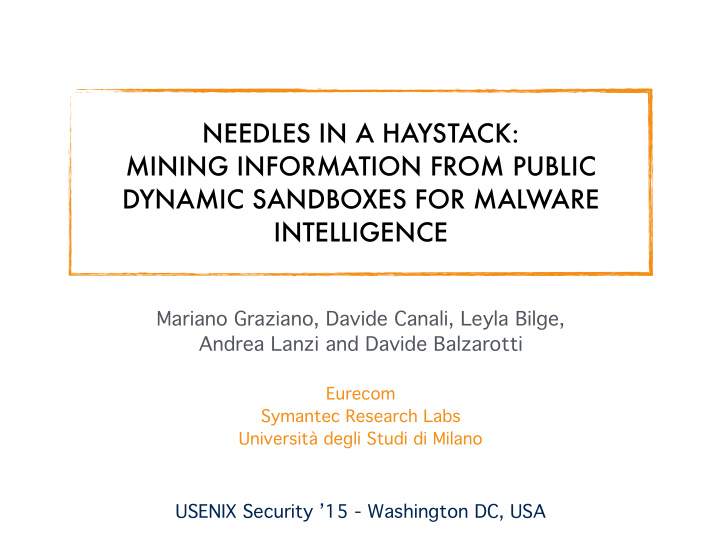



NEEDLES IN A HAYSTACK: MINING INFORMATION FROM PUBLIC DYNAMIC SANDBOXES FOR MALWARE INTELLIGENCE Mariano Graziano, Davide Canali, Leyla Bilge, Andrea Lanzi and Davide Balzarotti Eurecom Symantec Research Labs Università degli Studi di Milano USENIX Security ’15 - Washington DC, USA
A ¡PILE ¡OF ¡MALWARE ¡SAMPLES
CAMPAIGN TIME BEFORE PUBLIC DISCLOSURE SUBMITTED BY Operation Aurora 4 months US Red October 8 months Romania APT1 43 months US Stuxnet 1 month US Beebus 22 months Germany LuckyCat 3 months US BrutePOS 5 months France NetTraveller 14 months US Pacific PluX 12 months US Pitty Tiger 42 months US Regin 44 months UK Equation 23 months US
Constant interaction criminals vs sandbox
GOAL ‣ Observation: Malware authors use public sandboxes to test their developments ‣ Design data mining techniques to automatically discover malware developments
SYSTEM ¡OVERVIEW
SYSTEM ¡OVERVIEW
DATA ¡REDUCTION 32M Initial Dataset
DATA ¡REDUCTION 6M Submitted by regular users
DATA ¡REDUCTION 522K Not already part of large submissions
DATA ¡REDUCTION 214K Previously unknown by Symantec & VirusTotal
DATA ¡REDUCTION 121K Final (not packed binary)
SYSTEM ¡OVERVIEW
CLUSTERING ‣ Agglomerative clustering ( similarity threshold: 70% ): ‣ Binary similarity ( ssdeep ) ‣ Submissions metadata ‣ Sliding window of seven days: ‣ Reduce comparisons ‣ Ensure binary similarity ‣ 5972 clusters 4.5 elements each
SYSTEM ¡OVERVIEW
FINE-‑GRAINED ¡ANALYSIS 92% 74% 87% ‣ Binary code normalisation ‣ Call graph comparison [Flake04,Gao08] ‣ Control flow graph comparison [Flake04,Kruegel06,Jang13]
SYSTEM ¡OVERVIEW
FEATURE ¡EXTRACTION ‣ Comprise two phases: ‣ Per sample (25 features in 6 groups) ‣ Per cluster (48 features in 5 groups)
SAMPLE ¡FEATURES
CLUSTER ¡FEATURES
CLUSTER ¡FEATURES
CLUSTER ¡FEATURES UNKOWN UNKOWN MALICIOUS
CLUSTER ¡FEATURES COMPLEX BEHAVIOR COMPLEX BEHAVIOR NO BEHAVIOR
SYSTEM ¡OVERVIEW
MACHINE ¡LEARNING ‣ Logistic Model Tree (LMT) ‣ Training Set (157 clusters): ‣ Non development: 91 clusters ‣ Development: 66 clusters
RESULTS ‣ 3038 potential development clusters ‣ 1474 malicious clusters ‣ 135 days on average for the detection ‣ Thousands of computers infected in 13 countries CLUSTERS TYPE 1082 Trojans 83 Backdoors 65 Worms 45 Botnets 21 Tools 4 Keyloggers
EXAMPLES
ANTI-‑SANDBOX s n n Sample 1 Sample 1 Sample 2 Sample 3 u w w o o o i c n n 17:06:06 17:14:16 16:59:33 i k k l a Submission time n n M U U Compile time t 16:59:13 17:05:21 17:13:26
ANTI-‑SANDBOX s n n Sample 1 Sample 1 Sample 2 Sample 3 u w w o o o i c n n 17:06:06 17:14:16 16:59:33 i k k l a Submission time n n M U U Compile time t 16:59:13 17:05:21 17:13:26
TROJAN ¡DROPPER 22:35:08 00:44:06 01:18:48 01:25:16 13:07:26 SUBMISSION TIME DELPHI VB COMPILE TIME 1992-06-20 1992-06-20 1992-06-20 1992-06-20 2008-10-04
TROJAN ¡DROPPER 22:35:08 00:44:06 01:18:48 01:25:16 13:07:26 SUBMISSION TIME DELPHI VB COMPILE TIME 1992-06-20 1992-06-20 1992-06-20 1992-06-20 2008-10-04 ‣ VirusTotal: 37/50 ( trojan dropper ) ‣ Two IP addresses: ‣ Dynamic DNS service (no-ip) ‣ Connect-back behavior overall 1817 clusters
LIMITATIONS ‣ No packed binaries ‣ Evasions: ‣ Sandbox interaction still required to develop evasion techniques ‣ Most sophisticated analysis techniques require to link a probe to the final malware
CONCLUSION
THE ¡END THANK YOU graziano@eurecom.fr magrazia@cisco.com @emd3l
Recommend
More recommend